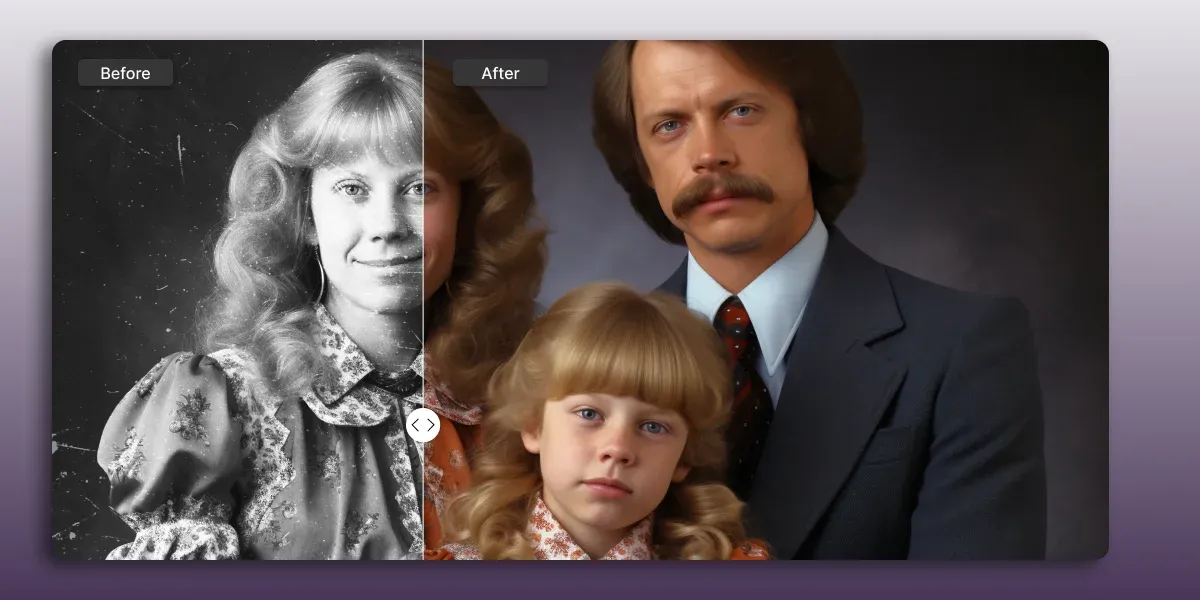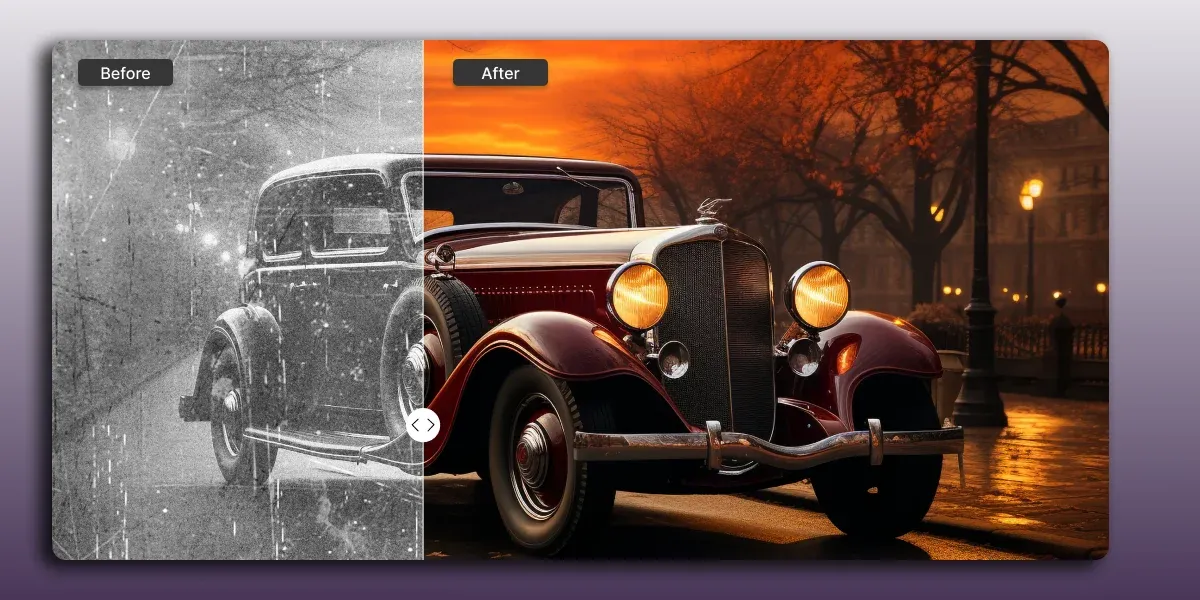Why Restore Old Pictures?
Discover why restoring old pictures can bring back memories and preserve history. Learn how AI photo restoration works and get tips to rejuvenate your cherished photos.
Table of Contents
- 1. Introduction
- 2. Reasons to Restore Old Images
- 3. What is the AI Photo Restoration Feature?
- 4. Tips to Restore Old Pictures
- 5. Use Cases for Restoring Old Pictures
Introduction

In an era where digital photos can be taken, viewed, and shared in an instant, it's easy to forget the charm and history carried by old photographs. These images, often faded, torn, or discolored, are more than just paper; they're tangible links to our past, embodying memories, emotions, and stories of generations gone by. Restoring these photos is not just about preserving an image; it is more about reviving the life and stories embedded within them.
This blog guides you through the importance of restoring old pictures, exploring Phot.AI's innovative AI Photo Restoration feature, and offer practical tips for bringing your cherished memories back to life. Are you ready to bring your damaged pictures back to life? Let's check what Phot.AI's unique AI Photo Restoration feature holds for you.
Reasons to Restore Old Images
There are a lot of reasons to restore old or damaged images. Let us discuss some of the major reasons to use Phot.AI's Old Photo Restoration feature.
Preserving History: Photographs are visual histories, capturing moments, cultures, and landscapes that may no longer exist. Restoring them helps preserve these historical records for future generations, offering insights into how people lived, dressed, and interacted in different eras. It helps to gain knowledge about our past and ancestors.
Reconnecting with Loved Ones: Old pictures often feature family members, friends, and ancestors we may have never met or wish to remember. Restoring these images allows us to see their faces clearly, fostering a deeper connection with our past and bridging the gap between generations.
Healing and Closure: For those who have lost loved ones or wish to remember significant life events, restoring photos can provide a sense of closure and healing. It's a way to honor and keep the memory of these individuals and moments alive.
Protecting Against Loss: Physical photos degrade over time due to environmental factors like light, humidity, and handling. Digitally restoring and backing up these images ensures they are preserved against further damage and loss.
What is the AI Photo Restoration Feature?
AI Old Photo Restoration is a cutting-edge technology that applies artificial intelligence to repair and enhance old photos. Here's how it works:
Detects and Repairs Damage
AI algorithms in the Old Photo Restoration can automatically identify imperfections such as scratches, tears, and water damage, and meticulously repair them, often restoring the photo to its original condition.
Colorization
The technology can add realistic colors to black and white or sepia-toned photos, bringing them to life in a way that was previously impossible without extensive manual effort.
Enhances Clarity and Detail
AI Old Photo Restoration can sharpen blurred or faded details, making the subjects and backgrounds more visible and vibrant. Explore it on Phot.AI's Old Photo Restoration feature.
Adjusts Lighting and Contrast
Photos that have suffered from overexposure, underexposure, or fading can have their contrast and brightness levels adjusted automatically, enhancing their overall appearance.
Tips to Restore Old Pictures
Embarking on a photo restoration project can be rewarding. Here are tips to achieve the best outcomes:
Look at What Needs Fixing
Before you start fixing an old photo, take a good look at it. See what problems it has. Does it have scratches, is it torn, or has the color faded? Knowing exactly what's wrong will help you figure out the best way to fix it.
Pick the Right Tools for the Job
To fix old photos, you need the right software or service. There are many different tools out there. Some are easy to use and good for small fixes, like removing a tiny scratch or making the photo a bit brighter. AI tools can do amazing things like fill in missing pieces or make a black and white photo look like it was taken in color.
Be Gentle with Old Photos
If you are working with an actual, physical photo, you have to be very careful. Make sure your hands are clean and dry, or wear gloves. This is because the oils on your fingers can make the photo worse. Also, work in a clean area. You do not want dust or dirt to get on the photo.
Make a Backup
Always, always make a copy of the photo before you start working on it. This means scanning it and saving it on your computer or a cloud service. That way, if something goes wrong while you're trying to fix it, you haven't lost the original photo forever. You can just start over with the copy.
When It's Tough, Ask for Help
Some photos are so special or so damaged that you might not want to try fixing them by yourself. That's okay! There are professionals who know how to restore photos, and they can do things that might seem like magic. They know all the tricks and have the best tools.
Use Cases for Restoring Old Pictures

Bringing Family Photo Albums Back to Life
Imagine your family has an old photo album. The pictures inside are faded, maybe they're torn or have water spots on them. By restoring these photos, you can make them look as good as new. This isn't just about making the pictures look better; it's about preserving your family's history. You'll be able to clearly see the faces of your ancestors, the clothes they wore, and the places they lived in. It's like a time machine that lets you peek into the past. This is about connecting with your roots. Just like a detective puts together clues to solve a mystery, restoring old family photos helps you piece together your family's past. It can turn a blurry, indistinct face into a clear image of a great-grandparent you never met, making your family history more real and tangible.
Enhancing Photos for Historical Research
Researchers who study history love old photos because they can tell us a lot about how people lived in different times. But if a photo is too damaged, it's hard to see the details that matter. Restoring these photos can help researchers see things they might have missed, like the writing on a sign in the background or the pattern on someone's clothing. It makes the photo a clearer window into the past. Restoring these photos is like cleaning off a dirty window so you can see out of it clearly. It helps historians make new discoveries and insights about how people lived, what they valued, and how our world has changed over time.
Artistic Projects
Artists often use old photos as inspiration for their work. But sometimes, the photo they want to use is too faded or damaged to be helpful. By restoring the photo, artists can see the original colors and details more clearly, which can inspire new artwork. It's like giving artists a clearer muse to spark their creativity. Additionally, some artists might integrate these restored images directly into their art, creating a blend of old and new or commenting on the passage of time.
Conclusion
Here, we have shared the major reasons why you should restore old pictures. Try using Phot.AI’s unique Old Photo Restoration feature to edit and enhance old images instantly and effortlessly. Our tool with generative AI restores old, damaged photographs in the best possible way making them look as fresh as newly clicked ones. Go and check out the tool now!
Phot.AI is an all-in-one image editing tool featuring an AI Old Photo Restorer. There are also AI Image Enhancer, Object Replacer, AI Image Extender, Background Generator, AI Art Generator, and other features for enhancing photo editing capabilities.